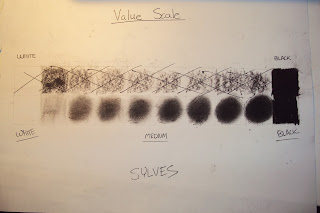1)
The first video that I watched was "Aesthetics: Philosophy of the Arts." I did not know that philosophers "looked down" on artists. Since artists tend to imply that they understand or formulate things that they cannot possibly understand.
I also learned that the judgement of taste is a perception. It cannot be judged as true or false. Art is the copy of what is real. Art can be anything. The only stipulation is that the "art world" must recognize it as art. New styles are born and transforms the path of art. The meaning of beauty is almost dissolved in a sense. It became almost a mute point.
The CARTA video presented a few key scientific points when judging and understanding art. The first portion recaps the evolution of the human brain and its ability to "access the consciousness." Changeux refers to the rules of art. Rules in the sense that the brain commits an art form to long term memory.
Ramachandran's presentation was phenomenal and quite fascinating. He came up with 8 Laws of Art. This includes: grouping, peak shift principle, contrast, isolation of a single cue, perceptual "problem solving," symmetry, abhorrence of specific vantage points/suspicious coincidences, and art as a metaphor. Works of art may use one or a combination of a few (if not all) of these laws. Some of the best works of art use a majority of these principles.
I learned mostly from the CARTA video is how art is produced can create very different perceptions by the brain. The brain picks up many different cues from art that create logical and emotion reactions.
The CNN article brought to my attention certain ways that our brains are wired to recognize. I did not know that our brains are generally looking to seek out faces in our environment. I also learned how color and luminance can be manipulated to tricking our eyes into seeing things that are not there.
2)
I believe that George Dickie's philosophical propositions to art are invaluable. Dickie belonged to the philosophy of the 20th century. Dickie believes that art is anything that the art world will accept. These types of thought in regards of philosophy and art are the impetus for the rapid expansion of art. Art opened to new styles, forms, and methods. Dickie's philosophy aided in the erosion of the previously necessary use of "beauty" in art.
3)
I did not enjoy Changeux's presentation nearly as much as Ramachandran's presentation. Changeux seemed overly analytical, or technical may be a better word, for something so dynamic as art. Art is based heavily on emotion. Looking into the way humans perceive art within the brain is interesting, but overkill in my opinion. It takes away from the full experience when thinking about art. Finding the connection between the limbic system and and prefrontal cortex is probably the best part of Changeux's research. This is important due to it representing the link between our thoughts and our emotions when doing something as judging art.
Ramchandran's research is fantastic. I believe that his 8 Laws of Art (listed above) are spot on. The reason for this is because of their ability to identify what causes our responses to art. These Laws become a guideline for understanding what one is perceiving when looking over a work of art. Using them as a guideline may provide a foundation for a deeper understanding and appreciation of each art work.
4)
The reading in the book relates to the videos and article in a few critical ways. The book reading sets a foundation for what art is and those that create art. It outlines different forms of art and their subsequent styles and variations. The final chapter for the reading introduces the common themes that art revolves around. The videos and article build upon these concepts. The first video mentioned above, explains how the thoughts and philosophy of art has evolved over time. The CARTA video and the CNN article delve into the reasons why and how the brain perceives art in certain ways and how it creates a reaction within the brain.
These, when combined, allow me to feel comfortable with judging, appreciating, and understanding art.
5)
As previously mentioned, portion of the CARTA video was a little too heavy for me--in regards to art at least. Everything else was interesting and quite useful. It adds depth to what we have been learning in the book. The article and videos present the "how" we perceive art; to some extent they even answer the "why" question. With these questions answered, now I am able to focus on the art and learning more about classifications, history, and continue to ask new questions about art. These laid the groundwork in order for me to begin experiencing art without being ignorant or naive to the reality, or lack thereof, of art.

